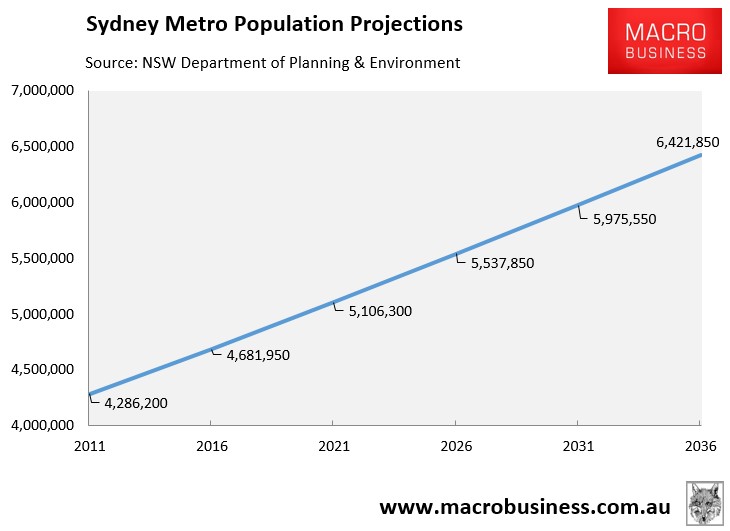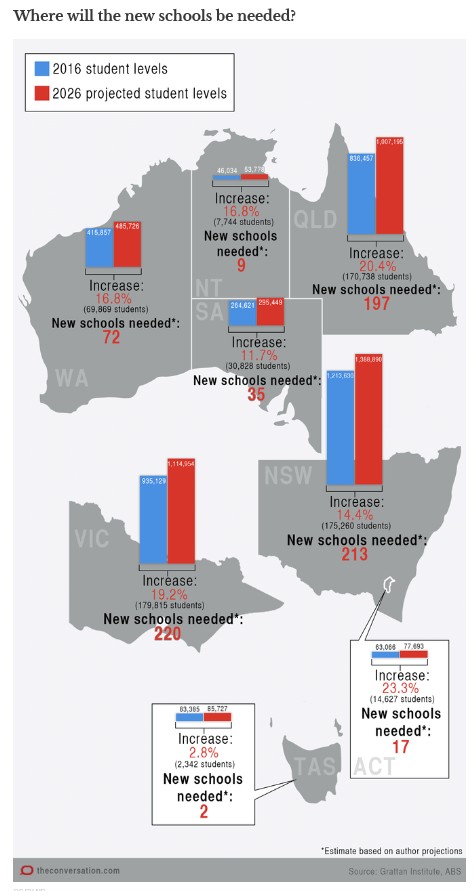Last month, The ABC reported that Sydney’s public schools are suffering from chronic over-crowding as they struggle to keep pace with rampant population growth:
A Sydney school where running at recess is banned because of overcrowding has been told the State Government is scaling back a promised expansion, which means students will not get extra play space…
In the past ten years the school has almost doubled in size to 1,200 students…
The NSW State Government acknowledges it is facing an unprecedented level of student enrolments.
It is currently allocating funding for nearly 50 schools to be either built or redeveloped.
But student numbers are expected to increase by nearly 25 per cent by 2031.
“Particularly in Sydney where there are new apartment blocks going up in Sydney all the time,” said Joan Lemaire from the Teachers Federation.
“We definitely need the Government to step in and begin a much bigger building program.
“We see that as a priority, maybe a priority bigger than building roads and railways.”
The school funding shortfall to deal with population growth is estimated by the auditor general to be as much as $10 billion.
Yesterday, we got another dose of the population ponzi in action, with another report about Sydney’s over-crowded public schools emerging on The ABC:
As the new school year begins, Chatswood Public is one of the schools across Sydney wondering just how to fit everybody in.
In 2006 there were around 670 students at the northern suburbs school. By last year, that number had almost doubled to 1,160…
Like other schools, Chatswood is using demountable classrooms to accommodate the increase in student numbers…
NSW Opposition Leader Luke Foley said the Government had never been in a better position to spend more on school infrastructure.
“I just don’t understand that at a time of record stamp duty windfall revenue for the Government, we’re not expanding the schools that are jam-packed,” he said…
The Opposition’s education spokesman, Jihad Dib, said the Government’s planning policy had also pushed student numbers up.
“A thousand new units in a period of two years just highlights the fact that this Government is very friendly towards the developer,” he said.
“We need to see a government that is also taking the responsibility of implementing all of the services, including the right for everyone in their catchment area to go to their local public school.”
In the decade to 2015, Sydney’s population grew by just over 700,000 people or by 17% – the equivalent of almost two Canberra’s.
And the NSW Government’s official population projections have Sydney’s population growing by 1,650 people per week (87,000 people per year) over the next 20 years – representing total population growth of 1.74 million people, which is the equivalent of 4.5 Canberra’s:

The overcrowding of Sydney’s schools is just one area of collateral damage from Australia’s mass immigration program. To this you can add worsening traffic congestion, deteriorating housing affordability, and an overall erosion of public services and livability.
Back in February 2016, Peter Goss, School Education Program Director at the Grattan Institute, penned an excellent article in The Conversation assessing the upcoming shortage of schools across Australia’s capital cities as the nation’s population balloons. This article estimated that the number of school students would balloon by 650,000 (17%) by 2026, which would require the building of an additional 400 to 750 new schools (up from 9,400 currently). NSW (mostly Sydney) would need an additional 213 schools to cope with an additional 14% of students over the next decade, whereas Victoria (mostly Melbourne) would require an additional 220 schools to cope with an additional 19% of students (see below graphic).

Inner city areas would be worst affected by the schools shortage, according to Grattan:
In the inner city, the big issue is the cost and scarcity of land… Governments have been much worse at planning for the booming number of inner-city children…
Worse is to come, especially in Melbourne. Melbourne’s five most central local government areas will each see a 30% to 60% increase in student numbers over the next decade… Inner-city parents in urban redevelopment zones are the most likely to have problems getting their children into a government school.
All of this, yet again, highlights Australia’s dysfunctional population ponzi in action. And to make matters even worse, the Turnbull Government recently relaxed visa rules to allow 6 year-old foreign students and their guardians visa entry into Australia’s primary schools, thus adding to the demand pressures.
Running a mass immigration program without adequate planning and investment means incumbent residents will spend more time lost in traffic, spend more on (smaller) housing, receive less public services (e.g. health and education), and experience overall lower living standards.
The equation is that simple, but largely ignored by our negligent politicians, policy makers and mainstream media.

